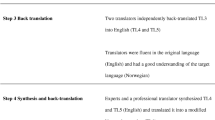Abstract
Objective: Analysis of data from the National Survey of Coronary Heart Disease patients to develop a core measure of patient experiences of health care. A secondary purpose was to determine whether a single summary index figure could be generated from the instrument. Design: The data reported here comes from the survey of coronary heart disease (CHD) patients, which was the second in the programme of National Surveys of National Health Service (NHS) patients. It took place during 1999. After an in-patient episode for CHD, questionnaires were mailed out to patients with a covering letter and a pre-paid stamped addressed envelope. Those patients who did not reply within two weeks of the initial mailing were sent a reminder letter and, if this elicited no reply within two weeks, they were sent another copy of the questionnaire. Sample: Of the 116,872 patients who were sent questionnaires, 3399 proved to be ineligible or out-of scope to the survey. Responses were gained from 84,310 (74.3% of eligible respondents). Results: Reliability analysis supported the existence of seven dimensions which seem to be tapping distinct underlying phenomena: hospital environment, information and communication, patient involvement, co-ordination of care, discharge and transition, and pain. Higher order factor analysis indicated these dimensions constituted one factor and, consequently, can be summed to create an index figure. The construct validity of the measure was assessed, and it distinguished between groups as was hypothesised. Conclusions: The dimensions of the questionnaire have high internal reliability. Both the dimensions of the instrument and the index score were found to have high construct validity. The instrument provides a core set of issues that should be covered when assessing the quality of care for hospital patients with coronary heart disease.
Similar content being viewed by others
References
Cleary PD, Edgman-Levitan S, et al. Patients evaluate their hospital care: A national survey. Heath Affair 1991 (Winter): 254–267.
Jenkinson C. Assessment and evaluation of health and medical care. In Jenkinson C (ed.) Assessment and Evaluation of Health and Medical Care. Buckingham: Open University Press, 1997.
Fitzpatrick R. The assessment of patient satisfaction. In Jenkinson C. (ed.) Assessment and Evaluation of Health and Medical Care. Buckingham: Open University Press, 1997.
Jenkinson C. Measuring Health Status: A Brief but Critical Introduction. Oxford: Radcliffe Medical Press, 1998.
Fitzpatrick R, Hopkins A. Problems in the conceptual framework of patient satisfaction research: An empirical exploration. Sociol Health and Illness 1983; 5: 297–311.
Coulter A, Cleary P. Patient experiences with hospital care in five countries. Health Affair 2001; 20: 244–252.
Cleary P, Edgman-Levitan S, McMullen W, Delbanco T. The relationship between reported problems and summary evaluations of hospital care. Qual Rev Bull (February) 1992; 18: 53–59.
Gerteis M, Edgman-Levitan S. Health care quality. Incorporating consumer perspectives. J Am Med Assoc 1997; 278: 1608–1612.
Finkelstein BS, Singh J, Silvers JB, Neuhauser D, Rosenthal G. Patient and hospital characteristics associated with patient assessments of hospital obstetrical care. Med Care 1998; 38 (Suppl 8): AS68-AS78.
Young GJ, Meterko M, Desai KR. Patient satisfaction with hospital care. Effects of demographic and institutional care. Med Care 2000; 38: 325–334.
Jackson JL, Chamberlin J, Kroenke K. Predictors of patient satisfaction. Soc Sci Med 2001; 52: 609–620.
Baker R. Characteristics of practices, general practitioners and patients related to levels of patients' satisfaction with consultations. Br J Gen Pract 1996 46(October): 601–605.
Tucker JL, Kelley VA. The influence of patient sociodemographic characteristics on patient satisfaction. Mil Med 2000 165(January): 72–76.
Cleary PD, Edgman-Levitan S, Walker JD, Gerteis M, Delbanco TL. Using patient reports to improve medical care: A preliminary report from ten hospitals. Qual Manage Health Care 1993; 2: 31–38.
Gerteis M, Edgman-Levitan S, Daley J, Delbanco TL. Introduction: Medicine and health from the patient's perspective. In: Gerteis M, Edgman-Levitan S, Daley J, Delbanco T. (eds) Through the Patients Eyes. San Francsico: Jossey Bass, 1993.
Airey C, Bruster S, Calderwood L, et al. National Surveys of NHS Patients-Coronary Heart Disease 1999. National Report: Summary of Key Findings. Department of Health.
Picker Implementation Manual. Boston: Picker Institute; 1999.
Coulter A, Fitzpatrick R. The patients perspective regarding appropriate health care. In: Albrecht G, Fitzpatrick R, Scrimshaw S. (eds) The Handbook of Social Studies in Health and Medicine. London: Sage, 2000.
Oppenheim B. Questionnaire Design, Interviewing and Attitude Measurement. London: Pinter, 1992.
Author information
Authors and Affiliations
Rights and permissions
About this article
Cite this article
Jenkinson, C., Coulter, A., Bruster, S. et al. The coronary heart disease in-patient experience questionnaire (I-PEQ (CHD)): Results from the survey of National Health Service patients. Qual Life Res 11, 721–727 (2002). https://doi.org/10.1023/A:1020818500819
Issue Date:
DOI: https://doi.org/10.1023/A:1020818500819




